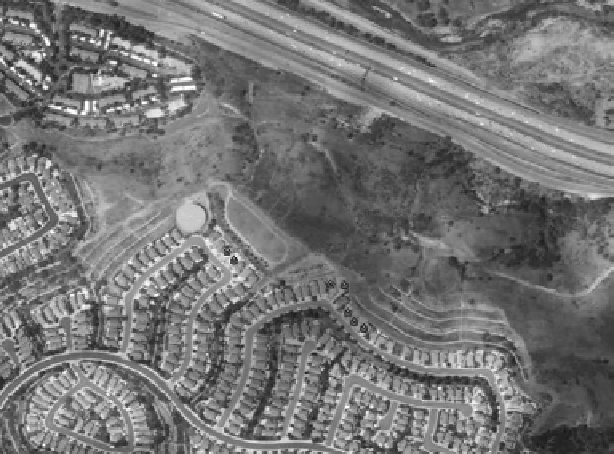Agriculture Reference
In-Depth Information
Fig. 13.6
Prefire aerial image of urban housing adjacent to wildlands affected by the 2008
Freeway Fire in southern California. Flames on the seven houses on the upper perimeter
indicate they were destroyed by the fire; houses at the WUI on the left have substantial clearance
between homes and wildlands and houses on the right had a well-watered greenbelt.
(From C.J. Fotheringham & J.E. Keeley unpublished data.)
space sufficient to eliminate direct home ignition from the flaming front is not
enough to ensure homes will not be lost. Commonly firebrands travel substantial
distances and can result in housing losses even when significant fuel reduction
buffer zones are in place (
Fig. 13.6
). Once fire ignites structures, fire spread within
the urban environment can be both from direct heat flux from the burning
structure as well as from embers transferred to other buildings.
Thus,
E
in
Equation (13.1)
is heavily dependent on the fuel level in the interface
zone plus the firebrand load impinging on the urban environment, as well as
weather and fire fighting resources. In both Australia and California it is apparent
that firebrands are the primary cause of house loss (Ramsay
et al.
1995
; IBHS
2009
). Fuel age, wind speed and vegetation structure all seem to be critical factors
in determining ember spread to homes (Ellis
2003
), and can be exacerbated by
prior drought (Keeley & Zedler
2009
). Wider buffer zones are sometimes justified
on the basis that they will reduce firebrand load on urban environments. However,
the source of destructive embers is probably one of the most critical knowledge
gaps in fire management. We have little information on the spatial arrangement of
fuel treatments for effective reduction in firebrand delivery to urban environ-
ments. This is particularly important to determine since evidence suggests
firebrand transport can be many kilometers beyond a fire front, and perhaps
much further in rugged terrain or under extreme wind conditions (Luke &
McArthur
1978
; Albini
1979
). Embers are capable of destroying homes well over
a half kilometer into urban environments (Chen & McAneney
2004
).

